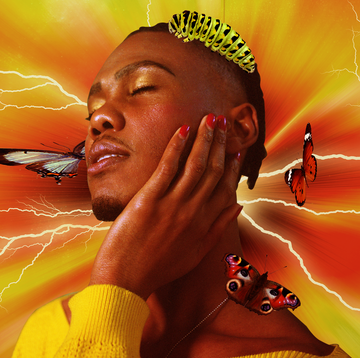The concept of gender spans across a spectrum. And as we know by now, it goes way beyond identifying as strictly male or female. Gender has become very nuanced in that, for many individuals, they now have the opportunity to identify with new terms more suitable to their body and preferences.
But even if you do identify with the sex assigned to you at birth, as an ally, it’s important to understand the language behind gender-related terms. (And yes, this includes always, always, always asking for someone’s pronouns instead of assuming.)
It’s also important to remember that similar to sexuality, gender can be fluid. For this reason, you must keep in mind that someone’s gender identity may change over time. And that’s okay. It’s extremely personal and not something that’s totally your business unless otherwise noted.
So whether you identify with one of these terms or just want to become a better ally, here are 12 terms essential to creating a more inclusive and respectful environment for everyone.
1. Agender
A person who identifies as agender might experience an “absence of any gender feelings or affiliation,” says Courtney D’Allaird, assistant director of Gender and Sexuality Resource Center at the University of Albany. (Remember that “a” as a prefix means “absence of something,” so agender = absence of gender.)
2. Gender nonconforming
Gender nonconforming is an umbrella term that includes “anyone or anything that challenges gender expectations,” says D’Allaird. In other words, gender nonconforming people “challenge and subvert gender stereotypes and expectations.” In some societies, there is a set of expectations that come with each gender—like women wear pink and men wear blue—but those who identify as gender nonconforming reject that way of thinking entirely.
3. Sex
As it relates to gender, sex often refers to what doctors (and society) assign a person at birth based on their genitals, whether male or female. Licensed psychologist and LTBTQ+ sex educator Liz Powell notes that defining sex versus gender is a complicated area, as many folks wonder how helpful it is to think about sex as a separate thing from gender.
“But in context, if we’re talking about someone’s sex, we’re talking about what they were assigned at birth, based on external genitalia,” they clarify. For the sake of most discussion, this is a helpful way to frame it.
4. Gender
While sex is based on biology, chromosomes, and what doctors assign at birth and write on the birth certificate, gender is a social construct, meaning something that was created by humanity, complete with its own set of “rules” and expectations.
As such, individuals may identify with a different gender than what they were assigned at birth. As Powell explains it: “Gender is someone’s own internal understanding about whether they are a man or a woman, something in between, or none of those things.”
5. Cisgender
Cis, which is short for “cisgender,” refers to people whose gender identity matches the sex they were assigned at birth. So if you were born with a penis and you feel and consider yourself to be male, you’d be a cisgender male.
6. Cishet
Cishet is short for “cisgender heterosexual,” or someone who is both cis and straight. (Note: “Straight” is not a gender term—it’s a sexual orientation. However, it’s relevant to gender when combined with “cisgender.”)
7. Transgender
Trans is an abbreviation of “transgender” and refers to someone whose gender does not align with the sex they were assigned at birth. “Trans is not aligned with what was determined [at birth], where cis is aligned with what was determined,” says therapist Kelly Wise, PhD, who also identifies as trans.
A transgender man is someone who was assigned female at birth but has transitioned (or is transitioning) to expressing a male gender identity, and a transgender woman is someone who was assigned male at birth but has transitioned (or is transitioning) to expressing a female gender identity.
8. Genderqueer
Genderqueer refers to someone who enjoys playing with that political and activist sense of the experience of expressed gender, Powell explains. A genderqueer person may identify as neither gender, both, or a combination. They do not subscribe to the traditional gender binary.
“I identify as genderqueer, because a lot of times I feel like a woman, and a lot of times I feel like a dude who feels like wearing women’s clothes. Sometimes I feel like a dude who doesn’t wear women’s clothes. I think that it’s a complicated thing,” Powell says.
9. Gender fluid
Someone who is gender fluid feels that their gender can change and vary over time. “People who are gender fluid find themselves moving between different gender presentations and identifications,” Powell says. “They may identify as a man or masculine one day and as femme, woman, or feminine another day and move between these expressions of their gender.” They may use gender-neutral pronouns such as they/them, as can non-binary or genderqueer people.
10. Non-binary
Non-binary is an umbrella term for people whose gender is not just male or female, Powell explains. And (staying on the theme) this word may have different meanings to different people. “Non-binary is anyone…outside of gender or someone who is transgender or people who don’t fall strictly within the binary at all,” Powell says. Someone can be trans, gender fluid, genderqueer, and non-binary all at the same time.
11. Intersex
People who are intersex are born with ambiguous genitalia. For instance, someone might be born with genitals that appear female on the outside but have male-typical anatomy internally, explains the Intersex Society of North America. Doctors in birthing rooms often have different opinions on how genitals should look to be categorized as male, female, or intersex (a power which is a little creepy, IMO), which is why it’s important to let individuals identify with whatever gender feels right for them.
12. Orientation
Sexual orientation is completely separate from gender identity. One refers to who you’re attracted to, while the other refers to your gender. This is important and often misunderstood. While someone who is non-binary or trans may identify as gay or bisexual, various gender identities can also have a heterosexual sexual orientation.
Taylor is the former Sex and Relationships editor who can tell you exactly which vibrators are worth the splurge, why you’re still dreaming about your ex, and tips on how to have the best sex of your life (including what word you should spell with your hips during cowgirl sex). You can follow her on Instagram here.













